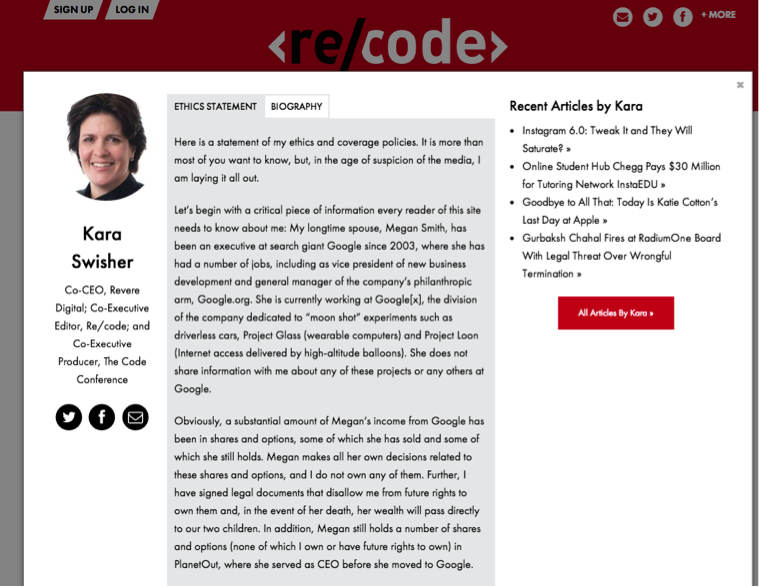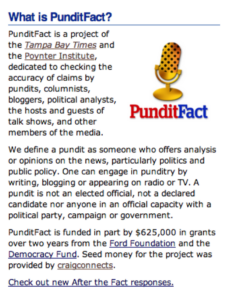When an earthquake struck Los Angeles in March 2014, the Los Angeles Times was able to quickly publish an article that contained basic data about the quake. At the bottom of that story was an interesting disclosure:
This information comes from the USGS Earthquake Notification Service and this post was created by an algorithm written by the author.
The story byline belonged to Ken Schwencke, a journalist on the Times Data Desk. But as the above line explained, the story itself was automatically generated by an algorithm Schwencke wrote to grab the USGS earthquake data and quickly assemble it in a basic news story.
This was such an unusual scenario that the Times deemed it necessary to include a disclosure of the method within the story. It was the right call.
Looking across the landscape, we conclude there are typically five situations when a disclosure needs to be added to a piece of content:
- Personal connections to sources, organizations or events mentioned in reporting.
- Organizational links to sources, organizations or events mentioned in reporting.
- Limitations of any data or material used. (Meaning: Here’s what we don’t know, or some mitigating factors.)
- When unusual methods are used to gather information (such as in the above example).
- When there is an unusual arrangement with sources (such as enabling them to remain anonymous or use a pseudonym).
I. Make disclosures within content
Disclosures are typically placed within the context of the content itself, or at the bottom of the page.
When disclosing an arrangement with a source, it’s important to insert it right after the first mention of the source, rather than make people go all the way through without understanding important details about that person. This is particularly true with anonymous or pseudonymous sources.
The NPR Ethics Handbook section on transparency requires its journalists to reveal as much as possible about an anonymous source without risking identification:
When a decision is made to use information that we have obtained from a source that must remain anonymous, we describe in as much detail as we can (without revealing so much that we effectively identify that person) how they know this information, their motivations (if any) and any other biographical details that will help a listener or reader evaluate the source’s credibility.
It’s also best practice to also offer an explanation of why someone is being granted anonymity or pseudonymity, and to explain as much about them as possible. For example a New York Times story about Libya included this disclosure paragraph:
More than half a dozen American diplomatic, military, law enforcement, intelligence and other administration officials were contacted for this article. All spoke on the condition of anonymity because of the diplomatic delicacy of the matter and the prospect of future military operations.
Philip Corbett, the Times’ standards editor, outlined guidelines for the description of anonymous sources in a memo. He warned that “Pat, formulaic expressions of why an anonymous source wants to be anonymous are probably worse than no explanation at all. They are uninformative and give readers the impression that our anonymity rules are on autopilot.”
Corbett offered these guidelines for disclosing information about why sources were granted anonymity:
Reporters and editors should in all cases discuss why the source wants anonymity, and consider seriously whether we can say something informative or interesting.
When warranted, a thoughtful sentence or paragraph, describing the pressures or concerns of the people involved in a situation, may give readers greater insight than a terse phrase. In other cases, a shorter explanation may be useful, but only if it conveys some real information.
For issues that relate to a reporter or outlet’s connection to someone or something mentioned in the story, the standard practice is to note it in a “disclosure.” For example, a Gigaom story about the parent company of WordPress includes this:
Disclosure: Automattic is backed by True Ventures, a venture capital firm that is an investor in the parent company of Gigaom.
Or this example from a post on Poynter by writer Andrew Beaujon:
Disclosure: My wife recently began working on a freelance basis for Quartz’s sister publication The Atlantic as a researcher.
Ideally, the disclosure should be placed as close to the relevant passage as possible. This connects the relevant story content to the disclosure, as with the source example outlined above.
II. Make disclosures about the editing process
A reporter’s name, email, phone number and even Twitter handle are now common information that accompanies their content. But some news organizations are now also disclosing the names and contact information of editors. Reuters, Bloomberg and smaller organizations such as the Missourian list the editors of an article at the foot of the story.
On Bloomberg stories, such as this one, the editors are listed at the bottom as part of a call to action for people to get in contact:
The Missourian discloses the supervising editor responsible for a given story. This is done in part, according to Mayer, because the paper’s staff is primarily made up of students from the University of Missouri’s journalism school, which means there is constant turnover.
“It’s important for us because the face of the Missourian is transient…” she said. “So we’ve seen some positive relationships with sources and communication with readers since we started pointing out who edited [the story], and linking to that person’s bio, just so there’s a more permanent source for contact.”
An instructive example of an editor bio page is this one for public safety and health editor Katherine Reed. Along with basic bio and contact information, it lists her most recent articles and comments on the site, and it includes a brief Q&A with her about the work she does. Mayer says this helps signal to people the kind of information Reed might be interested in, and it provides a human face.
“We definitely are hearing from more people, and a couple of our city editors have said they are getting more tips,” Mayer said.
III. Journalist disclosures
Beyond disclosures about specific reporting, more reporters and organizations are offering pages that are updated over time to disclose any personal ties, investments or relationships.
Re/Code, the technology news and reviews site run by Walt Mossberg and Kara Swisher, requires each reporter to maintain an ethics page, a practice they also did for years when they ran All Things D under the umbrella of the Wall Street Journal. This is where they list any relevant financial holdings, relationships with companies, or other items that require disclosure.
Swisher said she and Mossberg originally wanted to highlight reporter disclosures in a way that stood out from everyone else in the tech press.
“One of the things we decided early on was that it was important,” Swisher said.
The inspiration was the fact that her previous employer, The Wall Street Journal, required reporters to sign a standard ethics statement. But that statement was never shared with readers. And any specific disclosure that needed to be added to an article would be restricted by space constraints.
“So we felt, why not have a full public disclosure?” she said.
The Re/Code Ethics pages maintained on an ongoing basis, they are given good visibility by being linked to from every reporter’s byline:
Swisher’s ethics page, which she describes as “epic,” is written in plain language and explains, among other things, that her wife is a senior executive at Google. It describes how Swisher approaches this in her coverage of Silicon Valley.
Her ethics page begins, “Here is a statement of my ethics and coverage policies. It is more than most of you want to know, but, in the age of suspicion of the media, I am laying it all out.”
Swisher’s page details her approach to reporting, her financial holdings, her policy for accepting speaking fees, the structure of the parent company of which she is a co-founder, and much more.
Swisher also offers specific information about the financial arrangements she and her wife made to preserve her independence: “I have signed legal documents that disallow me from future rights to own [her wife’s Google shares] and, in the event of her death, her wealth will pass directly to our two children.”
As Swisher notes at the top of the ethics statement, it’s more exhaustive than would be necessary for many journalists, but the detail is there purposively, to make a point about her motivation to be transparent and therefore trustworthy.
“I have a much more complicated personal life [than the average reporter] and … I wanted to show what you can do,” she said. “I’m trying to numb you into submission about my personal life, but most of [the ethics statements] are short.”
Swisher says readers love the ethics pages.
“It’s so easy [to do] and I have to say readers really, really love it,” she said. “We’ve gotten dozen and dozens of letters over the years. They are shocked by it, and thrilled.
IV. Organizational disclosures
PunditFact, an offshoot of PolitiFact, offers a paragraph of disclosure about its sources of funding right on its homepage.
“When we launched PunditFact we made sure to include how it was being funded,” said PolitiFact editor Holan. She said the persistent disclosure is a result of her paying attention to a question that she was is asked when speaking publicly about PolitiFact.
“I do a lot of public speaking and people often ask who owns PolitiFact,” she says. So the homepage disclosure is a way to answer a question they know people often ask. It’s as much a service to people as it is an ethical effort.
Distilled from the work of others, here are four keys to doing organizational disclosures:
- Whenever possible, place disclosures within the context of the content. Ensure people get the information about a source, organization etc. when they first encounter it.
- Determine the questions that people ask about your organization’s operations/funding/ties? What questions are reporters always asked about how they invest/vote/volunteer etc.? These questions are your roadmap for knowing what to proactively disclose.
- Error on the side of disclosure. It’s better to share the information early and often, rather than have something come out later that raises questions about your independence and credibility.
- Create a dedicated place for reporters and your organization to make disclosures. This helps create a habit for staffers, which means people will think more about any disclosures they need to make, and therefore be less likely to forget to share something.
Obstacle to Expect and Overcome: Journalists saying that maintaining a disclosures page is too much work. Swisher says the ethics statements take very little time to write, and require infrequent updates. “We just hired someone from Mashable and he sent it to me yesterday and he wrote it in like four seconds,” she said. She also makes it clear to all editorial staffers that it’s not an optional activity. “All our reporters get it immediately and they don’t have a problem with it at all,” she said. “And if they do, too bad.“
Share with your network
Build credibility through transparency
You also might be interested in:
As research continues to inform this slice of the news industry, we’ll continue learning, too. Who gets to be called a journalist in 2025 and beyond? What is the future of trustworthy information, especially considering the access to and trust for online content creators? How might journalism adapt to the rise, or co-opt the styles, of news influencers?
What if we started looking at our output as a product, not a service? Too often, we think "product" means a fancy app or a new website. But product isn’t about tech. It’s about intention.
When we began asking what kind of stories still mattered to Baca County, we realized many of them weren’t “breaking news” but generational memory. And the paper was the last remaining platform that treated those memories with care and context.







